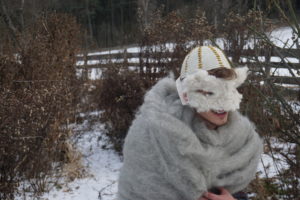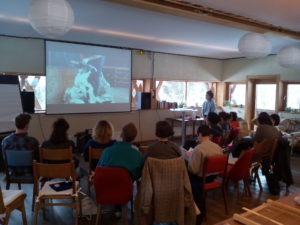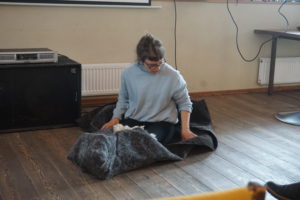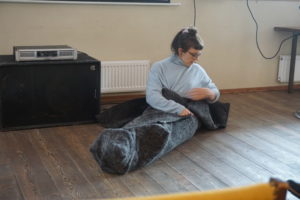Reflections on EXPLORATIONS #03 Making Wool Futures
Mountain wool: New applications, products and perspectives
A muu-baa workshop held at Stanglerhof, St. Konstantin, Völs am Schlern, Südtirol on Saturday, 19 January 2019.
This workshop was attended by 13 participants comprising teachers, researchers, students and alumni from the Faculty of Design & Art, unibz, a founder of BAU and several NGO workers. The day was co-facilitated by Prof. Alastair Fuad-Luke (AFL) of unibz and Theresa Bader (TB), an alumni of the Masters in Eco-Social Design at unibz who has been exploring potential uses of waste raw sheep wool from South Tyrol. The key aim of this six-hour hands-on workshop was to share our knowledge and to generate ideas and concepts for how we can make new combination of materials and artefacts from raw, carded and felted wool from South Tyrol. An important focus was on trying to develop new relations between the sheep, as wool producers, and people who have little or no contact with sheep other than through consumer products.
Report is here Reflections on Explorations no 3 Making Wool Futures AFL 310119; photos by AFL and TB

Wool, a versatile material: A participant wrapped in carded wool, wearing a raw wool health face mask and proudly showing his felt hat made during the workshop.
Introductory talks
Theresa explained the background to her project Rewollte and how she had experimented using the felting machines of Bergauf, Val d’Ultimo/Ultner to create new patterns, textures and applied designs to the felt fabrics. She then demonstrated one of her prototypes, a simple felt shape that can be wrapped around the whole body for health giving experiences. Cleaned raw wool can be stuffed between the body and the outer felt wrap to create an absorbent layer that cocoons the body. The wrap with wool causes gentle sweating and the pores on the skin open up. Perspiration is absorbed and the skin is cleansed in a process like a “dry” sauna. Theresa showed other prototypes including a face mask, neck warmers and so on. She believes that this system can be customized to meet individuals’ needs.



She is passionate about finding ways of adding value to the 50 tonnes of waste sheep wool generated each year in South Tyrol and will continue developing prototypes to test new applications beyond bulk uses such as wool as a mulch, fertilizer and soil conditioner.
Alastair gave a short talk. He commenced by reminding participants that humans domesticated sheep some 8000 years ago, as evidenced by rock art drawings in the Middle East. The Fat-tailed sheet depicted in these drawings is still found in the region. The semi-feral Soay sheep represents a distant relative of Neolithic sheep in the UK. These and other sheep suited to mountain areas tend to have coarse wool but breeding programmes over centuries created greater variance of wool in terms of length, fibre type and softness. Today, in South Tyrol, five breeds dominate: Tiroler Bergshaf, Schwarzbrunes Bergshaf, Villenosser Brillenschaf, Schnalser Schaf and Juraschaf. These breeds provide the fibre for traditionally hand-crafted products made in South Tyrol, including felt slippers, woolen cardigans, wool rugs and felted hats.
Woolen textile manufacturers, such as Lanificio Paoletti in the nearby province of Veneto, experiment with “zero-kilometer” production using the Alpogata sheep but also weave very different fabrics from imported wool from all over the world.
The second part of Alastair‘s talk focused on ways different artists and designers have tried to find new uses for wool and develop new relations between the materials, their production and the consumers. For example, Christina Meinderstma create One-Sheep Cardigan where the wool of one rare-breed sheep was used to knit one unique jumper. Fashion designers including Vik Prjonsdottir, Bianca Cheng Costanzo and Sibling Knitwear continue to surprise us with dramatic panels, folding and knitting techniques for eye-catching effects. Versatile felt provides options for folded and stiched footwear and furniture. Yet, these designs still maintain a distance between the sheep, its producer and the consumer. How can we create new relationships?
Introducing participants to the materials & tools
Participants were shown the differences between wool in different states: from cleaned raw wool to carded wool, felt and wool yarn. They were introduced to a range of simple hand tools – a drop spindle for spinning yarn from carded wool; wooden lucets for square and round cords from wool yarn; various cutting tools and knitting/crochet needles and two small hand or lap looms for weaving.
The sheep/human timeline
Participants were asked to contribute “post-its” to the wool timeline, 6000 BC to the present then tried to predict some future needs or trends. The tradition of making the tough, waterproof Loden wool cloth in South Tyrol goes back 400 years. The 1960s saw big changes in the wool producing industry in the area with the arrival of cheaper imports and tourists who demanded traditional woolen products. Today, only a few producers continue making jumpers/cardigans (the sarner), felt slippers () and hats but there is little innovation in terms of design, functions and new technologies.
This was the collectively generated timeline:
- 6000BC – domestication of sheep
- 5300BC – Ötzi the Iceman from the South Tyrol/Austrian border was wearing a loincloth of (domesticated) sheepskin leather (from DNA analysis) but not wool or woven textile was found.
- 1700BC – first evidence of Almwirtschaft in the Alps
- 700BC – tombs of nomadic peoples of Central Asia, Mongolia and the Middle East lined with felt
- Greek and Roman soldiers used felt for socks, tunics and boots
- Felter in South Tyrol?
- Decorative – Aesthetic purposes
- 1400AD Sarner
- 1500-1599, 16th century knitting
- 1600 Loden
- 1800-1899, 19th century crochet
- Sheep breeding and mixing. Globalisation?
- 1900 colonial imported cotton usurps wool
- 20th century, mixing wool with acrylic textiles or fibres
- Observe wool healing properties
- 1960s tourist felt and woolen products
- 1960s to 1980s early globalisation
- 1960 – 2000 Spinnrod als Dekoratino
- Hard to find pure local wool clothing
- “Traditional” tourist products
- New (re)wool “daune” sport-outdoor clothing
- New “Red Dot” Sarner
- NOW i.e. 2020
- Kilometer zero – new wave of sustainability
- Services to “get the best from your (farmer) wool” through a Wool-Lab
- Services for washing, carding
- A shared calendar for shearing in May/Oct to process wool
- Identification – know your sheep
- Wool as a health service for well-being
- Fun – superpowers of wool
- Think beyond textile
- 2050 new production techniques
Making products from local wool requires new ways of considering how to add value. This might mean that farmers producing wool have to have a shared calendar to come together to lower the costs of cleaning and carding the raw wool. An interesting concept of a Wool-Lab was briefly discussed – here individuals could obtain wool direct from the farm the learn how they could clean, card, spin or felt the wool to make their own unique artifacts. A new health service based around personalized wool products and experiences offers potential.
Concept storming and playing with materials
Theresa introduced a series of cards that described the different properties of wool fibres, their yarn and other materials to help the participants better understand the potential of this amazing natural material.
We continued by gathering around a large table to discuss possible concepts for creating artifacts that would help generate new relationships between producers and consumers, between wool/felt material suppliers and consumers and so on. Ideas were shared and many sketches generated. Some began playing with the materials to understand their diverse properties – raw wool, carded wool, felt of different grades and wool yarns. Several participants had a go at spinning their own yarn from the carded wool by using a drop spindle.
Exploring and making concepts/prototypes
The afternoon was dedicated to some serious making with the participants working individually, in pairs or small groups. Specialist craftspeople did not attend the workshop, yet the range and quality of artifacts was surprisingly good – an indication that these materials are adaptable by people from diverse backgrounds.
One group of three dedicated themselves to making a complete finished product. Two made small cushions; one with interwoven strips, the other hand stitched with wool yarn on the edge. Both were filled with raw wool. These participants thought that cushions like these could be easily made by school children starting their first primary school. It is the kind of artifact that could last them through their early school years. The last participant of this group decided to make something he really needed – an oven glove, with a personalized design integrated into the felt using a felting needle.
Another group of three also developed a concept aimed at early school children. They conceived constructing a life-sized plywood sheep (laser-cut in the BITZ Fab Lab, unibz) which children would then cover with a woollen “wrap”. The wrap could be made of individually felted squares sewn together onto a felt base i.e. it would be a collective work that could include many narratives from the childrens’ perspectives. They could visit a farm to see the sheep, get involved in carding then felting the wool. The wrapped sheep becomes something that is huggable, something to be cherished.
Two participants spun their own wool, although the lightweight spindles meant the wool had to be twisted more than spun, making it thick but tough. Knitting the new wool yarn proved challenging but created a super-chunky knitted texture that could be worn close to the skin. Much discussion ensured about the beneficial medical properties of wool worn close to the an injury, such as a bruise, or sore throat.
Others continued experimenting with the materials through knotting, interweaving and stitching felt strips, carded wool or raw wool. The latter proved interesting to weave in a small hand loom, by twisting it to form a coarse thread.
Some experimental artifacts
Here are some of the artifacts produced during the workshop.
During the workshop Theresa started weaving with raw wool on a lap loom, threaded with hemp warp. After the workshop this was further continued with carded wool (rolled prior to weaving), felt strips and wool yarn. Another lap loom was threaded with strips of naturally dyed felt to show the potential of using thin offcuts. These roughly woven artifacts demonstrate the huge variety of textures that can be further experimented with for weaving carpets, felted textiles or other goods.
Summing up
This short workshop, largely attended by amateur makers, shows there is considerable potential to explore new uses of the different types of wool materials – raw wool, carded wool, felt, wool yarn and their imaginative combinations. Concepts developed for involving schoolchildren in making new connections to wool as a resource included the “personalized cushions” and “creating a “collective wrap for a plywood sheep”.
Follow-up workshops on sheep wool are planned by the muu-baa network in March and April 2019.
